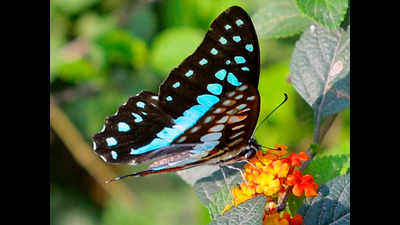- News
- City News
- delhi News
- Season’s greetings: How delayed spring has made Delhi a hotspot for butterfly lovers
Trending
This story is from April 22, 2019
Season’s greetings: How delayed spring has made Delhi a hotspot for butterfly lovers

Picture used for representational purpose only
NEW DELHI: The longer winter — and, consequently, the delayed spring — has turned out to be a blessing for nature lovers. They can now watch a variety of butterflies, most of which are now coming to life after spending the harsh winter in pupal stage. The city’s butterfly parks are now teeming with colourful wings.

At Lodhi Garden’s Butterfly Park, spread over one-and-a-half acres, the horticulture department has planted more than 30 species of nectar flora to attract butterflies.Between 9am and 10am, when it starts getting warm, you have a chance to discover grass jewel (the smallest butterfly in the world), Indian cabbage white, common jay, plain tiger and lemon pansy along the trail.
Besides, there is a conservatory where you can see butterflies that have drawn their names from all sorts of flowers, birds and even animals.
Chellaiah said added: “To attract maximum varieties of butterflies at the garden, we have planted a combination of flower plants that provide nectar for adults and host plants for their caterpillars, such as lantana, Limonia, jatropha curcas, camellia, milk weed, justicia, bauhinia, jasmine, anar, phalsa and lemon tree.”
The butterflies can also be seen in ample numbers at Yamuna Biodiversity Park, Aravalli Biodiversity Park and Asola Bhatti Wildlife Sancturay.
“We have 67 varieties of butterflies at Yamuna Biodiversity Plant. These include common mormon, striped tiger plan, small salmon arab, plain tiger, white arab, common crow and pioneer. Besides March and April, September end and October beginning are considered to be the ideal months of butterfly sightings,” Faiyaz Khudsar, a wildlife biologist and scientist-in-charge of YBP, said.
Looking for butterflies, said Khudsar, meant looking anywhere from one feet above the ground to the tree canopy.
To mark the 83rd birthday of Lodhi Garden, NDMC has transplanted eight new species of trees there. Their lifespan will be more than 300 years, said an NDMC official.
“Since the garden is overcrowded, there is no space for planting more trees. Therefore, this year we decided to plant only eight trees of new variety. These included cochlospermum silk cotton tree, olea sp, kamadal tree and magnolia sp,” said an official.

At Lodhi Garden’s Butterfly Park, spread over one-and-a-half acres, the horticulture department has planted more than 30 species of nectar flora to attract butterflies.Between 9am and 10am, when it starts getting warm, you have a chance to discover grass jewel (the smallest butterfly in the world), Indian cabbage white, common jay, plain tiger and lemon pansy along the trail.
Besides, there is a conservatory where you can see butterflies that have drawn their names from all sorts of flowers, birds and even animals.
New Delhi Municipal Council horticulture director S Chellaiah said: “While the longer winter delayed shedding of leaves in Delhi, it also led to the arrival of spring a little later. That’s why you can still see flowering plants blooming at parks and roundabouts. So is the case with butterflies, which usually get attracted to flowering plants.”
Chellaiah said added: “To attract maximum varieties of butterflies at the garden, we have planted a combination of flower plants that provide nectar for adults and host plants for their caterpillars, such as lantana, Limonia, jatropha curcas, camellia, milk weed, justicia, bauhinia, jasmine, anar, phalsa and lemon tree.”
The butterflies can also be seen in ample numbers at Yamuna Biodiversity Park, Aravalli Biodiversity Park and Asola Bhatti Wildlife Sancturay.
“We have 67 varieties of butterflies at Yamuna Biodiversity Plant. These include common mormon, striped tiger plan, small salmon arab, plain tiger, white arab, common crow and pioneer. Besides March and April, September end and October beginning are considered to be the ideal months of butterfly sightings,” Faiyaz Khudsar, a wildlife biologist and scientist-in-charge of YBP, said.
Looking for butterflies, said Khudsar, meant looking anywhere from one feet above the ground to the tree canopy.
To mark the 83rd birthday of Lodhi Garden, NDMC has transplanted eight new species of trees there. Their lifespan will be more than 300 years, said an NDMC official.
“Since the garden is overcrowded, there is no space for planting more trees. Therefore, this year we decided to plant only eight trees of new variety. These included cochlospermum silk cotton tree, olea sp, kamadal tree and magnolia sp,” said an official.
End of Article
FOLLOW US ON SOCIAL MEDIA










